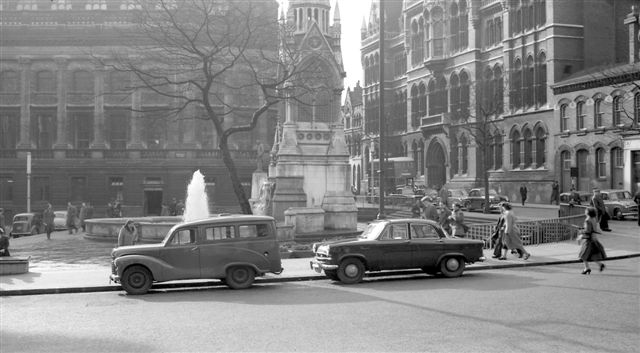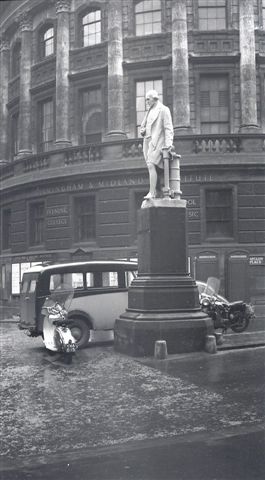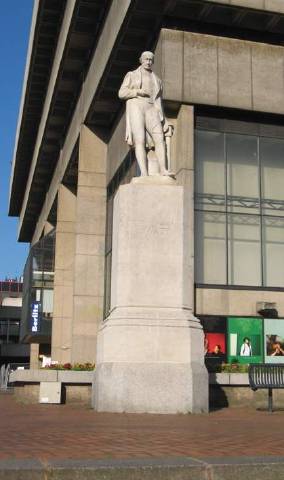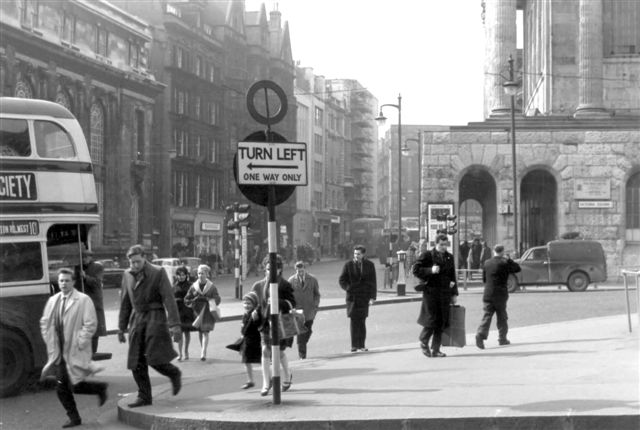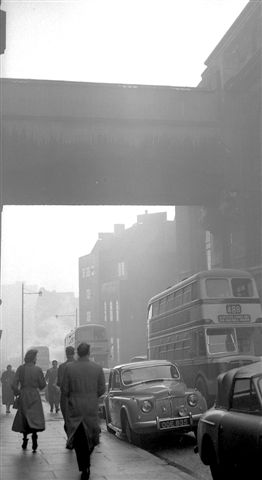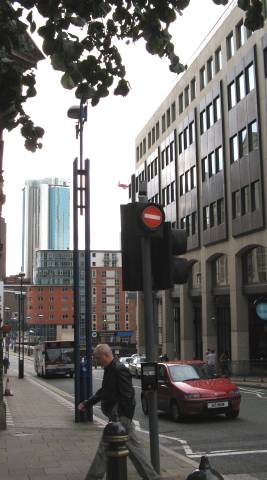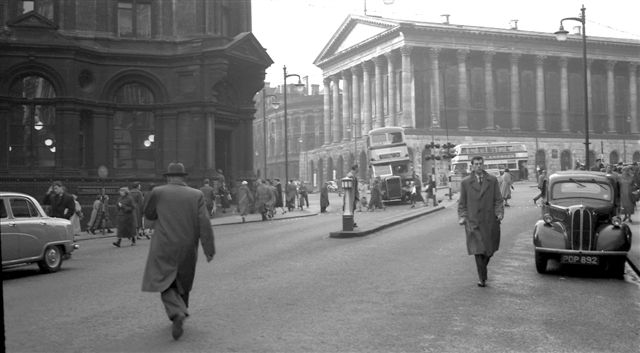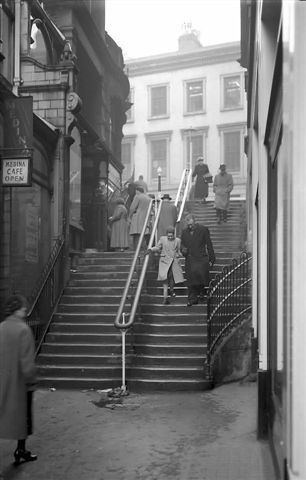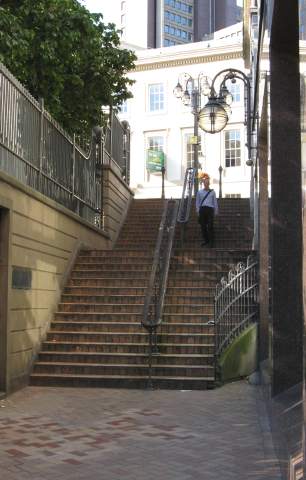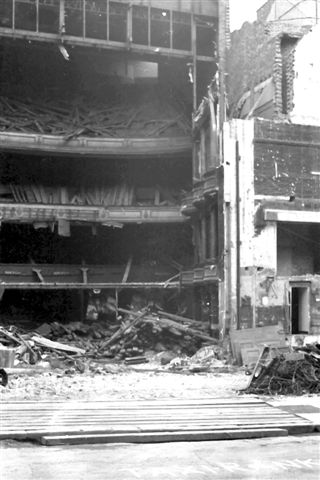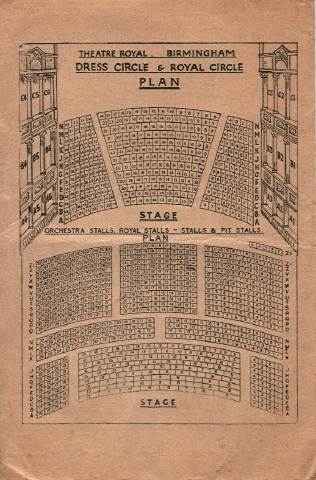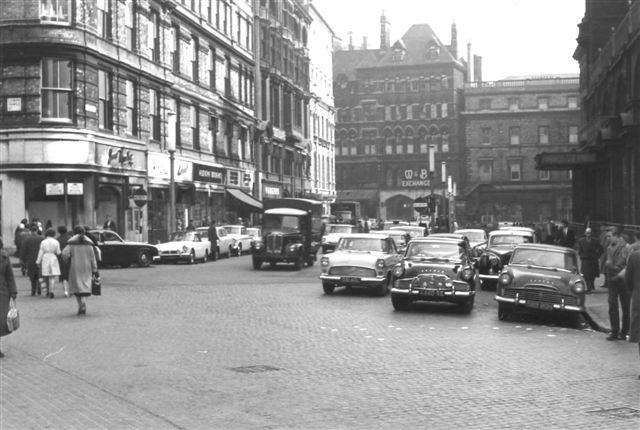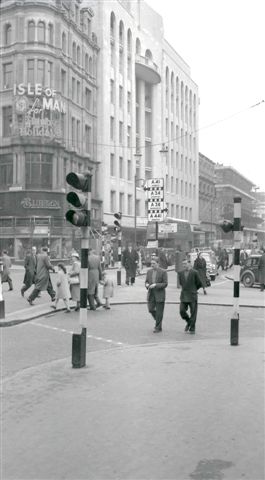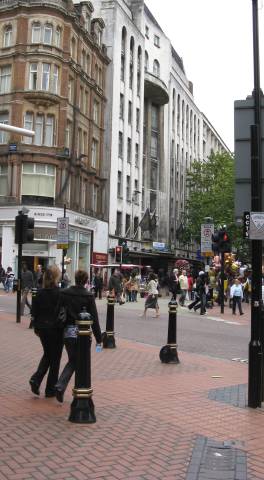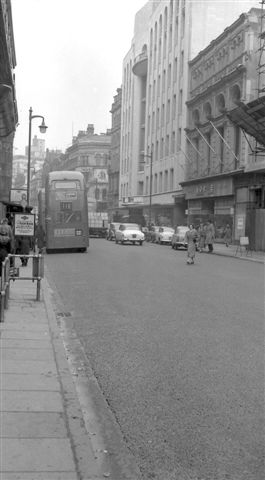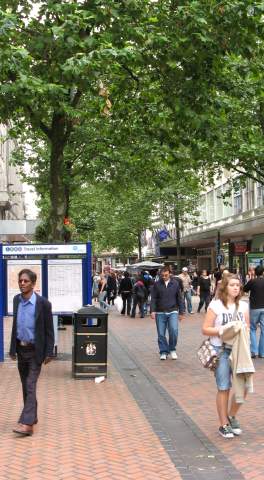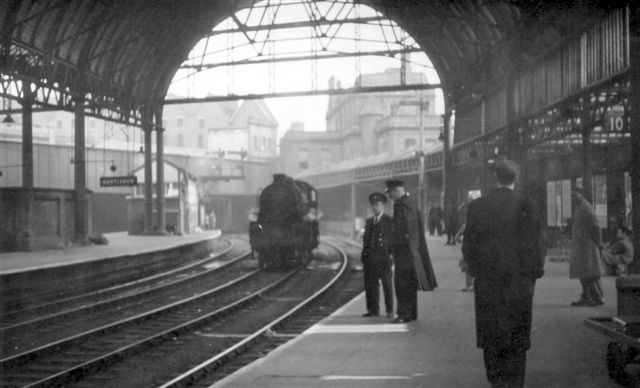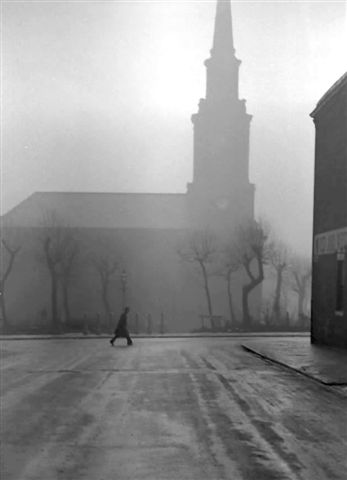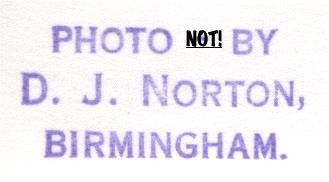
Photo's by Leonard Stace
When Bill Stace emailed these pictures to me I was very excited by what
I saw. One part of the city that I'd developed a fascination for
was the streets surrounding Chamberlain Square. Because
development in this area generally occurred after my father had died,
there was very little in the collection to show what had been lost
here. Through further study I found that fantastic Victorian
buildings like Mason College, the Central Library and the Midland
Institute had been swept away in the late 1960's and early
1970's. It seems that this destruction was seen by many as 'a
building too far' so last minute efforts were made to save the
Victorian Central Library and the conservation movement in the city
finally found a voice.
These pictures were taken by Leonard Stace with a camera he had
purchased from the well known Galloway's store - so well known that the
shops at the junction of Colmore Row and New Street were referred to as
'Galloway's Corner'. There are no dates for any of these pictures
but I have reached the opinion that they date from around 1961 until
1965. If you have any information to date the individual pictures
accurately then please get in touch!
I would like to thank Bill Stace for allowing me to show his late
father's photo's here. I'm sure you will agree that they
compliment my own father's work very nicely. We must be thankful
that Leonard Stace had the forethought to capture these stunning images.
If you have any old Birmingham photographs you would like to see
displayed on this website, please get in touch via the 'Contact' link
on the
Homepage.
Chamberlain Square from the Art Gallery steps
|
|
|
This picture from the steps of
the Birmingham Museum and Art Gallery clearly shows the part of the
city for which I feel a great sense of loss. In the foreground is
Congreve Street, a road that used to run from Colmore Row to Great
Charles Street. The building to the left is the Victorian Central
Library and to the right is Mason College, fronted by Edmund Street
before it had been curtailed.
I took a modern view of this location but I couldn't bring myself to
display it side by side with this picture. Those with the stomach
for it can click
here. If it wasn't for the presence of the Chamberlain memorial
there would be nothing to prove that these photographs really were only
seperated by time…
|
James Watt statue at entrance of Ratcliff Place
|
|
|
These two
pictures illustrate the dramatic change in the nature of Birmingham as
a city as profoundly as any you're likely to see. In Leonard's
photo, James Watt stands proud at the entrance to Ratcliff Place, a
road that use to exist to the western side of the Town Hall. In
the background is the Birmingham and Midland Institute designed by
E.M.Barry and opened in 1858.
My own photo from May 2007 shows James Watt in his new location outside
the Birmingham Central Library. The dramatic difference between
the Victorian and modern styles couldn't be more obvious. Many
fans of modern architecture will no doubt try and say that the current
Central Library is of great importance and should be admired.
Well, all I can say is that I know which I'd rather look at and I'm not
surprised that James Watt is looking at Chamberlain memorial rather
than the library!
|
Paradise Street from Victoria Square
|
|
|
A nice view into Paradise Street
taken from roughly where 'The
Iron Man' stands today.
The building behind the bus was the Royal Mail Parcels Office and it
survived until 1985.
|
Hill Street
|
|
|
A nice
atmospheric shot taken from close to the post office at the top of Hill
Street and looking down towards Navigation Street. Above is the
bridge that linked the post office to the parcels office on the other
side of Hill Street. In the mist half way down the hill is the
Golden Eagle pub which survived well into the 1970's only to be
demolished to make way for a small car park.
The modern view shows how this part of the city has been dramatically
redeveloped, especially in recent years, with the Orion Building and
Beetham Tower both visible.
|
Town Hall from New Street
|
|
|
Taken from the top of New
Street, this shot shows the Post Office and Town Hall covered in the
dirt and grime that was common at the time. I think the newly
refurbished Town Hall looks a bit too
clean now!
The Town Hall had an interesting start to its life. The original
design was by J. A. Hansom of 'Hansom Cab' fame but the project had
been costed too low and bankruptcy ensued in 1834. The building
was finished off by Charles Edge who had proved himself with the
construction of the Market Hall seen here.
|
Christ Church Passage
|
|
|
The part of
the city where Victoria Square is today was once occupied by shops and
offices including the famous Galloway's shop that Leonard Stace bought
his camera from. Before they were constructed, Christ Church
(built 1805) had occupied most of the land but it was demolished in
1899. This passageway was called, as still is called, Christ
Church Passage and links New Street to Waterloo Street. I've read
that the buildings were demolished with the intention of creating a
roundabout but plans to redevelop Colmore Row along the lines of the
Inner Ring Road were thankfully dropped! Still, it's nice to see
the steps remain even if the term 'passage' is now something of a
misnomer.
|
Demolishing the Theatre Royal, New Street
|
|
|
There had
been a Theatre Royal on New Street since 1777. The British
History website tells us that it had a classical façade that
was elegant and striking. The original building was replaced by a
new Theatre Royal in 1902. The theatre we see being demolished
here was very popular with Birmingham residents and my mother recalls
walking up endless stairs to get to 'The Gods' where the cheapest seats
were located!
This picture appears to have been taken roughly behind where the stage
would have been as it is clear we are looking at the seats within the
theatre as many an actor, actress, singer and other artist had done in
the past. I found a small envelope that had once contained
Theatre Royal tickets amongst my father's books and had this seating
plan printed on it - note the boxes to the right of the photo and the
plan.
There is some stunning colour film of the demolition of the Theatre
Royal taken by a resident of Guildhall Buildings (incorrectly referred
to as Stephenson
Buildings by my father) that has been shown on the Central TV
programme 'The Way We Were'. The theatre was replaced by a
Woolworths store with offices above.
|
Stephenson Street
|
|
|
Here's another location I've
developed a fascination for but one which my father didn't really
capture as development took place in the mid 1960's. Stephenson
Street featured the splendid Queens Hotel opened in 1854 and seen to
the far right of Leonard's picture. The rows of cars were no
doubt associated with the hotel. It would be demolished in 1966.
In the middle of the shot we get a glimpse of the gothic Birmingham
Exchange in Stephenson Place. This fantastic building lasted
exactly 100 years before being torn down in 1965. You can see
more of it in my father's
shot of Stephenson Place.
If you can bring yourself to look, here
is the scene today...
|
New Street / Corporation Street
|
|
|
This shot
was taken close to the old Midland Bank, now Waterstones book
shop. The old and new pictures have much in common for a
change! The biggest difference is that traffic in this area is
now restricted to buses using Corporation Street. In Leonard's
time, traffic for the A41 and A34 went up Corporation Street while
those seeking the A38 or A441 would be directed down Stephenson Street
and Stephenson Place.
|
New Street
|
|
|
I believe
that this shot was taken close to the entrace of the Odeon cinema on
New Street. Pedestrianisation and tree planting make it difficult
to prove that the old and new shots show the same location!
Behind the trees in the modern view is the large building the looms
large in Leonard's picture. It is now the Britannia Hotel and can
be clearly seen in the picture directly above. When the old
picture was taken in appears that New Street was one way towards
Corporation Street and Stephenson Place.
Out of shot to the right of the old photo was the 'Big Top' site.
Buildings here were so badly damaged during World War 2 bombing raids
that the site had to be cleared and a circus big top moved in for many
years before the area was redeveloped in the mid 1950's.
|
New Street Station
|
|
|
This picture shows the eastern
end of platfrom 10
on the Midland (south) side of New
Street Station. The arched roof had been built in
1884.
|
St Paul's Church from Caroline Street
|
|
|
This is a lovely atmospheric
shot of St. Pauls church which was built between 1777 and 1779.
The church sits in the centre of St. Paul's Square and the area is
little changed having escaped redevelopment in the 1960's and now being
part of the Jewellery Quarter Conservation Area. Development
restrictions are so tight that the façade
of a 1930's (my guess) factory in the north west corner of the
square was kept when the rest of building was demolished and rebuilt
for apartments!
|



